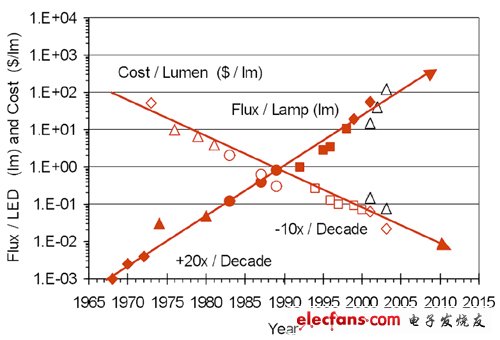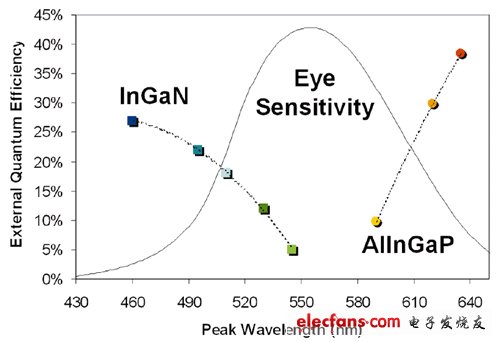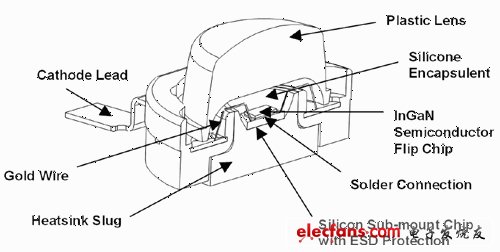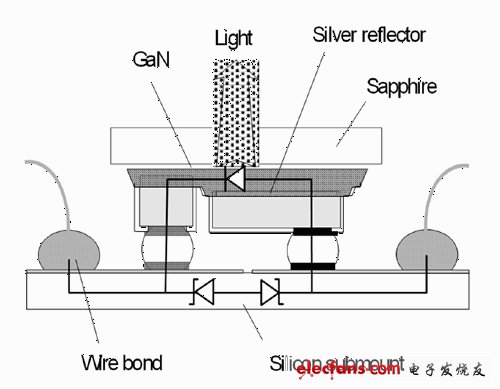In the past, LEDs can only be used as the status indicator. The heat dissipation of the package has never been a problem. However, in recent years, the brightness and power of LEDs have been actively improved, and they have been used in backlights and electronic lighting applications. The problem has quietly emerged.
The above-mentioned teachings are somewhat confusing. Isn’t the brightness of LEDs ever exceeded today? In 2003, Lumileds LighTIng's Roland Haitz based on an empirical technical inference law based on past observations, starting from the first commercial LED in 1965, in the development of these 30 years, LED is about every 18 months. In 24 months, the brightness can be doubled, and in the next 10 years, the brightness is expected to increase by 20 times, and the cost will be reduced to 1/10 of the existing one. This is also the Haitz law that has been popular in recent years. It is considered to be the Moore law of the LED industry.
According to Haitz's law, LEDs with a brightness of 100 lm/W (100 lumens per watt) appeared around 2008 and 2010, but the actual development seems to be more advanced than the law. June 2006 Nichia Chemical Industry (Nichia) Engineering samples up to 100lm/W white LEDs have been available and are expected to be officially put into mass production by the end of the year.

Remarks: Haitz's law can be said to be the Moore's law in the LED field. According to Roland Haitz, LEDs can double the luminous efficiency in almost 1824 months in the past 30 years, and thus estimate the next 10 years (2003) 2013) will grow 20 times more brightness, but the price will be only 1/10 of the current price.
Not only the brightness continues to increase, but also the heat dissipation technology of LED has been improved. In 1992, the thermal resistance of an LED was 360 °C / W, and then dropped to 125 ° C / W, 75 ° C / W, 15 ° C / W, Now it is at the point of 6 °C / W10 °C / W. More simply, in the past, for every watt of power consumed by LED, the temperature will increase by 360 °C. Now it consumes 1 watt of electricity, but the temperature only rises by 6. °C10 °C.
A small number of high-brightness, multiple and dense arrangements are the main cause of heat increase
Since the brightness efficiency is improved and the heat dissipation efficiency is improved, isn't it more contradictory? Should there be no more heat dissipation problems? In fact, it should be said more strictly that the heat dissipation problem is not high brightness, but high power; not in traditional packaging, but in new packaging and new applications.
First of all, in the past, it was only used as the LED of the indicator light. The current of each single (light conduction) is between 5mA and 30mA, which is typically 20mA. Now the high-power LED (Note 1) is Each single will have a current of 330mA1A, and each "power consumption" is increased by ten times or even tens of times (Note 2).
Note 1: In the practice of existing high-power LEDs, in addition to increasing the area of ​​single-emitting bare crystals, there are also practices in which multiple bare crystals are packaged together. In fact, some white LEDs are three kinds of bare crystals of red, green and blue in the same package to mix white light.
Note 2: Although the lighting (sudden conduction) voltages of various LEDs are different, this difference is temporarily ignored here.
When the multiplied current is sent in the same single package, the heat will naturally double, so the heat dissipation will certainly deteriorate, but unfortunately, because the white LED is used as the flash of the camera phone, it is used for small lighting. It is not enough to use a light bulb to make a lighting bulb inside the projector. It is not enough to use high brightness, and high power is used. At this time, heat dissipation becomes a problem.
The above LED application method uses only a few high-power LEDs, about 14 flashes, about 18 illumination bulbs, and more than 10 projectors, but the flash has less chance of use, and the lighting time is not long, single illumination. The light bulb has a relatively large space for heat dissipation, but the projector does not have ample heat dissipation space but can be equipped with a cooling fan.

Remarks: In the figure, the semiconductor materials used for InGaN and AlInGaP LEDs, the external quantization efficiency map at each peak wavelength (light color), although ideally can approach 40%, but if the light extraction efficiency is included Considering that it is actually between 15% and 25%, not to mention that the two materials in the more efficient part are not in the category of human eye sensitivity, only 20% under the category.
However, there are still many applications that require high brightness, but need to use high-brightness LEDs intensively, such as traffic lights, message lights, video walls made up of LED groups, etc. It is not easy to dissipate heat, which is the heat dissipation problem caused by the application.
What's more, in the backlight of LCD TVs, it is not only the use of high-brightness LEDs, but also densely arranged, and in order to pay attention to the short and light, the heat dissipation design space available on the back is more limited, and should not be considered if the requirements of high standards are met. Use a cooling fan, because the noise of the fan will affect the taste of TV viewing.
What are the side effects of the heat dissipation problem?
it is good! If the heat problem of the LED is not solved, and the operating temperature of the LED is raised, what effect will it have? There are two main effects on this: (1) weakening of the brightness of the light, and (2) decay of the service life.
For example, when the LED's pn junction temperature (JuncTIon Temperature) is 25 ° C (typical operating temperature), the brightness is 100, and when the temperature is raised to 75 ° C, the brightness is reduced to 80, to 125 ° C, 60, to 175. Only 40 is left at °C. Obviously, the junction temperature and the luminescence brightness are inversely linear. The higher the temperature, the darker the LED brightness.
The effect of temperature on brightness is linear, but the effect on life is exponential, also based on the junction temperature. If it is kept below 50 °C, the LED has a lifetime of nearly 20,000 hours, and 75 °C is only left. 10,000 hours, 5,000 hours at 100 ° C, 2,000 hours at 125 ° C, 1,000 hours at 150 ° C. The temperature light is changed from 50 ° C to 2 times 100 ° C, and the service life is reduced from 20,000 hours to 1/4 times 5,000 hours, which is extremely harmful.
Bare layer: divergent source of light and heat on both sides: pn junction
Regarding the heat dissipation of LEDs, we also discuss them from the core to the outside, and the head is also in the pn junction. The solution is to convert electrical energy into light energy as much as possible, and less into heat energy, that is, light energy boost. The heat is reduced to reduce fever.
If we discuss it further, the electro-optic conversion efficiency is Internal Quantum Efficiency (IQE). Today, 70% is 90%. The real problem lies in External Quantum Efficiency (EQE). The low.
Taking Lumileds LighTIng's Luxeon series LED as an example, the Tj junction temperature is 25 ° C, and the forward drive current is 350 mA. Thus, with InGaN, the efficiency is about 5% 27% depending on the wavelength (light color). The higher the wavelength, the lower the efficiency (the grass green is only 5%, the blue is 27%), and the AlInGaP aspect also varies with the wavelength, but the higher the wavelength, the higher the efficiency, and the efficiency is roughly 8%. 40% (light yellow is low, orange red is highest).

Remarks: It can be known from the cross section of Lumileds Luxeon series LED that the sealant fixes the phosphor on the bare and bare LEDs (if it is useful for phosphorescence), and then the lens is on the seal. The underside of the bare crystal is soldered (or thermal paste) to the Silicon Sub-mount Chip. This chip also enhances the ESD static protection. The heat sink is connected next to the chip, and some of the LEDs are also directly exposed to the bottom. The heat sinks are connected. (Source: Lumileds.com)

Remarks: The Lumileds Luxeon series of LEDs are covered by a flip-chip method, so the sapphire substrate becomes at the upper end, and a layer of silver is added as a light reflection layer to increase the amount of light extraction. In addition, it is also in the Silicon Submount. Two Zener Diodes are fabricated to stabilize the LEDs and make the operation more stable. (Source: Lumileds.com)
The increase in the light extraction rate (ExtracTIon Efficiency, also known as: twilight efficiency, light extraction efficiency) is equivalent to reducing the heat dissipation rate, which is equal to two sides of a subject, and for the improvement of the light extraction rate, please see another article: high Analysis of the principle of "package light" of brightness LED. It is not discussed here.
When you are out, Bluetooth Headset may be out of power, and no place to charge. Now Charging Case Earphone is the solution, the charging case could help charging earphone several time. Uninterrupted Bluetooth headset, different music world.
Charging case earphone provides charging standby, provide Bluetooth Earphone continue working time. All XT products can provide a charging case, which combines the storage and charging functions of the headset with a box to protect the earphones and supply the earphones. It can meet your needs for your earphone`s listening one day at least. It is also a customized product for modern life.
Charging Case Earphone
Charging Case Earphone,True Wireless Earbuds,Earphone With Charging Case,Wireless Earphone With Charging Case
ShenDaDian(China) Digital Electronics Co.,Ltd , http://www.btearbuds.com